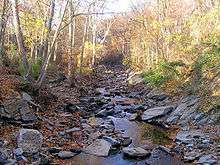Little Falls Branch (Potomac River)

Little Falls Branch, a 3.8-mile-long (6.1 km)[1] tributary stream of the Potomac River, is located in Montgomery County, Maryland. In the 19th century, the stream was also called Powder Mill Branch.[2] It drains portions of Bethesda, Somerset, Friendship Heights, and the District of Columbia, flows under the Chesapeake and Ohio Canal, and empties into the Potomac at Little Falls rapids, which marks the upper end of the tidal Potomac.
History
In the mid-19th century, the stream served as an interim water source for Washington, D.C. The Dalecarlia Reservoir was built on the D.C.-Maryland border next to Little Falls Branch. A dam was built on the stream, and water was diverted into the reservoir starting in 1859.[3]:29 In 1864, with the completion of the Washington Aqueduct, the Potomac River became the city's principal water source. However, muddy water from Little Falls Branch continued to flow into the reservoir, and a bypass pipe was built to channel the aqueduct water to another city reservoir, the Georgetown Reservoir. In 1895 construction was completed to fully divert the stream from the Dalecarlia Reservoir.[3]:74–75
Current conditions
Today Little Falls Branch flows through a highly urbanized area, and parts of the stream have been altered through construction of underground pipes, culverts and open concrete channels. Portions of the stream flow through Little Falls Stream Valley Park in Bethesda[4] and next to the Capital Crescent Trail. The stream runs near the Dalecarlia drinking water treatment plant in Washington and occasionally has received overflow discharges from the plant.[5]
According to a study conducted by the county government, the water quality of the stream and its tributaries is poor, due to water pollution from urban runoff, as well as the channelization described above.[6] The county and the Town of Somerset have installed several stream restoration projects throughout the watershed.[7][8]
Tributaries of Little Falls Branch
- Dalecarlia Tributary
- Little Falls Mall Tributary
- Spring Valley Tributary
- Willet Branch
See also
References
- ↑ U.S. Geological Survey. National Hydrography Dataset high-resolution flowline data. The National Map, accessed August 15, 2011
- ↑ William D. Haley, ed. "Philp's Washington Described: A Complete View of the American Capital and the District of Columbia," p. 195. (Washington, D.C.: Rudd and Carleton, 1861).
- 1 2 Harry C. Ways, "The Washington Aqueduct: 1852-1992." (Baltimore, MD: U.S. Army Corps of Engineers, Baltimore District, 1996).
- ↑ Montgomery County Department of Parks. "Little Falls Stream Valley Park." Accessed 2013-11-12.
- ↑ U.S. National Park Service, Washington, D.C. Statement of John Parsons, Associate Regional Director For Lands, Resources, and Planning, National Capital Region, National Park Service, Department of The Interior, before the Subcommittee on National Parks, Recreation and Public Lands, House Committee on Resources, Concerning Discharge Effects of the Washington Aqueduct. October 30, 2001.
- ↑ Montgomery County Department of Environmental Protection, Rockville, MD. "The Little Falls Watershed and Minnehaha Branch." Accessed 2010-04-16.
- ↑ Somerset Town Journal, Vol. 50, No. 3, September 26, 2005.
- ↑ Montgomery County Department of Environmental Protection, Rockville, MD. Little Falls Watershed News. Summer 2000.
External links
- Little Falls Stream Valley Park Trail - Montgomery County Parks
- Little Falls Watershed Alliance
Coordinates: 38°56′08″N 77°07′11″W / 38.935667°N 77.119701°W